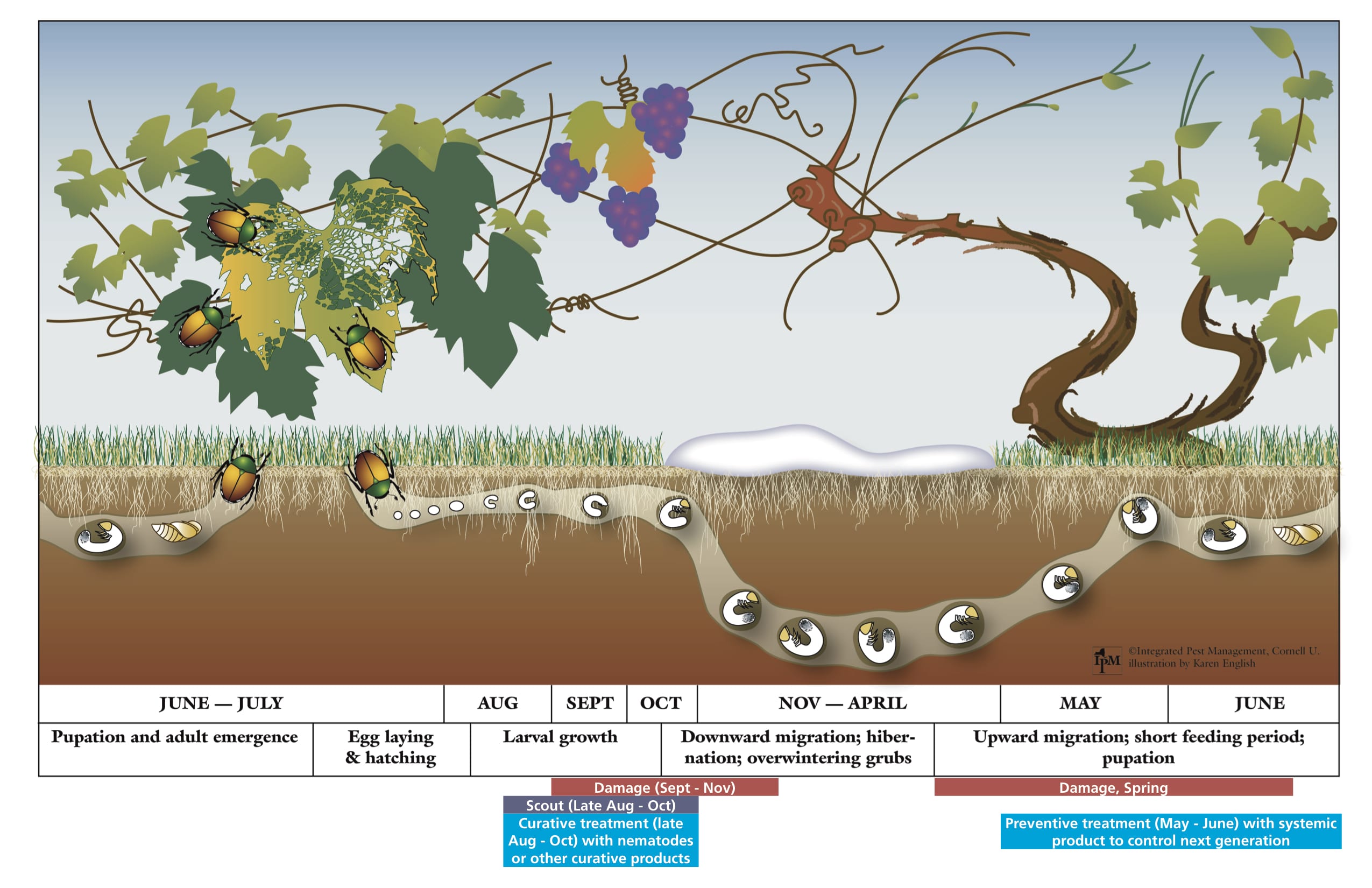
For much of this summer, many people in NY had “water” at the top of their lawn care list. White grubs are another concern for home lawns. But finding a grub in your lawn does not automatically mean that you need to treat. Before you think about doing anything to your lawn to kill grubs, you should know how many grubs you have, and which species they are. If you do need to treat, consider using biocontrol.
Good news! It’s the perfect time of year to scout for white grubs. Starting in mid to late August, and continuing into October, grubs that hatched from eggs laid during the summer will be just beneath the surface of your lawn, feeding on the roots of your grass plants. This is the time to look for grubs. You might also notice some damage to your lawn from white grub feeding during this window.


Take a look at this fact sheet for detailed instructions on sampling your lawn. All you need is a piece of paper, something to write with, and a shovel or trowel. Check 1 foot by 1 foot squares around the lawn. If you have a bulb planter with a diameter of approximately 4.25 inches, or a golf course cup cutter, this works, too. Make notes about where you’ve sampled and how many grubs you found in each spot. Save the grubs from each sampling location separately.

If you didn’t find any grubs, please don’t treat your lawn! You are wasting money, and applying unneeded pesticides (or biocontrol nematodes) is never a good idea. If you did find grubs, it’s important that you determine which species they are. Why? Because the white grubs you are likely to find in NY are the immature (larval) stage of many different insect species. And each species causes different amounts of damage to your lawn. This means that the number of grubs your lawn can tolerate before it’s damaged – and therefore the number of grubs you should tolerate before treating for grubs – depends not only on the overall resilience of your turf, but also on the grub species you have. Check out the following table:

Fortunately, identifying grubs is easy, too! All you need is a penny, a hand lens with at least 15x magnification, and this online Grub ID tool. First, use the green “Learn how to identify grubs” button to find out which part of the grub to look at and how to hold it. Next, follow the instructions to compare each grub you found to the size of a penny.


Finally, inspect its rear end with a hand lens to determine which species you have. Once you’ve identified the species, click on the species name to find specific management information. Now, look at that table again. For the species you found in your yard, do you have more than the listed number per square foot (or per 4.25-inch diameter soil core)? If not, then don’t waste time or money treating your lawn.
Most likely, only a few spots in your lawn (if any) warrant grub treatment. This is why you took careful notes about where you found grubs. Late August through September is also a good time to use a curative treatment for grubs in NY. The grubs are small and easier to kill. Some chemicals are effective when used at this time (but not the ones that are taken up by the plant!). A preventative pesticide that is taken up by the plant and kills the next generation of grubs when they start feeding in the late summer and fall should be applied in May or June. Before using any pesticide, find out if it is allowed in NY and find the product label using the New York State Pesticide Administration Database (NYSPAD). If a product isn’t listed in this database, you may not use it in NYS (even if you can buy it online). You must follow all instructions on the label.


But why use a chemical when you could use a biological control? Entomopathogenic nematodes are tiny beneficial worms that don’t harm plants, but kill grubs. See how they do it by watching this short video. Why wouldn’t you want these nematodes working for you? Beneficial nematodes are a curative white grub treatment, so they should be applied between mid to late August and October. But you still only need to apply them to spots where grub numbers exceeded the thresholds in this table. You can purchase nematodes from garden centers or online garden supply stores. Look for the nematode species Heterorhabditis bacteriophora and Steinernema feltiae.

For both species, make sure to follow the instructions on the package for storing and applying them. Nematodes will be harmed by ultraviolet light, so apply them around dawn or dusk, and water them afterwards to wash them into the root zone of the grass (where the grubs are). Any type of sprayer (as long as it doesn’t contain a fine mesh) or even a watering can will work to apply nematodes. If you use a sprayer, keep the pressure below 30 pounds per square inch. When you’re mixing up the nematodes, if non-chlorinated water is available, use that. Chlorinated water is fine for watering them in after you apply them.
Regardless of what treatment you use, scout your lawn again next year to find out how well your IPM strategy worked, and if there are other areas you need to treat (or not).
This post was written by Amara Dunn (NYS IPM) and Kyle Wickings (Department of Entomology, Cornell University).
